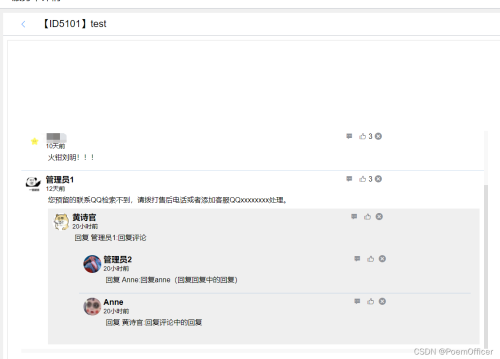转载声明:文章来源:https://blog.csdn.net/qq_43396436/article/details/121656487
一、数据库设计
评论表(TFW_Comments)和回复内容表(TFW_UserResponse)以及评论回复关系表(TFW_MsgRelation)

二、数据库设计思路:
注:各位读者自动忽略评论表的服务机构ID字段,这个字段相当于这条评论是在哪个帖子(文章下面)
1、根据文章ID或者是帖子ID查询评论表获取评论(本文的服务机构ID)。第一层(评论)
2、根据评论ID并且回复类型等于1的去关系表获取第二层的回复(commentsId)。第二层(评论下的回复)
3、根据评论ID、回复类型等于2、回复ID去关系表获取第三层回复。第三层(评论下回复中的回复)注:回复ID是它的上级
三、实现类源码
@Override
public Map<String, Object> findComments(JSONObject jsonObject) {
data.clear();
String userId = jsonObject.getString("userId");
String role = this.role(jsonObject);
if (role.equals("-1")){
//没有权限
data.put("error","-1");
data.put("msg","当前用户没有权限");
return data;
}
List<Map<String, Object>> info = commentsDao.findComment(jsonObject.getString("fWJLID"),null);
//查询点赞次数
int countTag = 0;
MsgRelationTag msgRelationTag = new MsgRelationTag();
for (Map item : info){
item.put("inputShow",false);
int commentsId = (int) item.get("commentsId");
//查询点赞次数
countTag = msgRelationDao.findCountTagByTagId(commentsId,1);
item.put("countTag",countTag);
//设置点赞状态
msgRelationTag.setTagId(commentsId);
msgRelationTag.setTagType(1);
msgRelationTag.setTagUserId(Integer.parseInt(userId));
MsgRelationTag msgTag = msgRelationDao.findMsgTag(msgRelationTag);
if (msgTag != null) {
item.put("tagStatus",msgTag.getStatus());
}else {
item.put("tagStatus","");
}
//如果有@id
if (item.get("atId") != null){
String content = item.get("content").toString();
StringBuffer tmrAtId = findUserName(item.get("atId").toString());
item.put("content",content+'@'+tmrAtId);
}
//二级回复数据
List<Map<String, Object>> twoReply = new ArrayList<>();
//所有数据
List<Map<String, Object>> userResponse = userResponseDao.findUserResponse(commentsId, null, "","",null);
for (Map userResponseInfo :userResponse){
int userResponseIds = Integer.parseInt(userResponseInfo.get("userResponseId").toString());
//查询点赞次数
countTag = msgRelationDao.findCountTagByTagId(userResponseIds,2);
//设置点赞状态
msgRelationTag.setTagId(userResponseIds);
msgRelationTag.setTagType(2);
msgTag = msgRelationDao.findMsgTag(msgRelationTag);
if (msgTag != null) {userResponseInfo.put("tagStatus",msgTag.getStatus());}else {userResponseInfo.put("tagStatus","");}
userResponseInfo.put("countTag",countTag);
userResponseInfo.put("inputShow",false);
Integer responseType = (Integer) userResponseInfo.get("responseType");
for (Map stairReplyInfo : userResponse){
Integer userResponseId = (Integer) stairReplyInfo.get("userResponseId");
int msgRelationId = Integer.parseInt(stairReplyInfo.get("msgRelationId").toString());
//接受者id*/
twoReply = userResponseDao.findUserResponse(msgRelationId, userResponseId,"1","",null); //二级回复数据
for (Map twoReplyItem : twoReply){
int twoReplyId = Integer.parseInt(twoReplyItem.get("userResponseId").toString());
twoReplyItem.put("inputShow",false);
//查询点赞次数
countTag = msgRelationDao.findCountTagByTagId(twoReplyId,2);
twoReplyItem.put("countTag",countTag);
//设置点赞状态
msgRelationTag.setTagId(twoReplyId);
msgTag = msgRelationDao.findMsgTag(msgRelationTag);
if (msgTag != null) {twoReplyItem.put("tagStatus",msgTag.getStatus());}else {twoReplyItem.put("tagStatus","");}
String userRepContent = twoReplyItem.get("userRepContent").toString();
if (twoReplyItem.get("tmrAtId") != null){
StringBuffer tmrAtId = findUserName(twoReplyItem.get("tmrAtId").toString());
twoReplyItem.put("userRepContent",userRepContent+'@'+tmrAtId);
}
}
stairReplyInfo.put("twoReply",twoReply);
}
}
item.put("stairReply",userResponse);
}
data.put("data",info);
data.put("error",0);
data.put("msg","查询成功");
return data;
}其它的代码可以忽略。主要语句有:
四、获取帖子下的评论
List<Map<String, Object>> info = commentsDao.findComment(jsonObject.getString("fWJLID"),null);上图根据FWJLID获取评论。(此处可以当成帖子的ID,获取帖子下的评论)一级展示
对应SQL语句(OPT是我的用户表)
select tc.content ,tc.commentsId,convert(varchar(19),tc.startTime,120) as startTime,tc.recipientId ,tc.operatorId,zo.NAME as operatorName,tc.atId,zo.HeadImgUrl as operatorHeadImgUrl
from TFW_Comments tc
left join zd_opt zo on zo.AID = tc.operatorId where tc.FWJLID = 5101查询结果:

五、获取评论下的回复
List<Map<String, Object>> userResponse = userResponseDao.findUserResponse(commentsId, null, "","",null);上图根据commentsid获取评论下的回复。(根据评论ID获取回复)二级展示
对应sql语句
select
tur.userResponseId,tur.operatorId,tur.recipientId,convert(varchar(19),tur.startTime,120) as startTime,tur.userRepContent,tmr.atId as tmrAtId,
tmr.msgRelationId ,tmr.responseType,tmr.replyId,
zo.NAME as operatorName,
zo1.NAME as recipientName,
zo.HeadImgUrl as operatorHeadImgUrl,
zo1.HeadImgUrl as recipientHeadImgUrl
from TFW_MsgRelation tmr
left join TFW_UserResponse tur on tur.userResponseId = tmr.userResponseId
left join zd_opt zo on zo.AID = tur.operatorId
left join zd_opt zo1 on zo1.AID = tur.recipientId where tmr.commentsId = 47查询结果

六、获取二级回复
twoReply = userResponseDao.findUserResponse(msgRelationId, userResponseId,"1","",null); //二级回复数据上图是根据评论ID(msgRelationId)和回复ID(userResponseId)去获取二级回复。回复ID也就是父类。就是回复那一条回复的ID。 第三层展示
对应sql
select
tur.userResponseId,tur.operatorId,tur.recipientId,convert(varchar(19),tur.startTime,120) as startTime,tur.userRepContent,tmr.atId as tmrAtId,
tmr.msgRelationId ,tmr.responseType,tmr.replyId,
zo.NAME as operatorName,
zo1.NAME as recipientName,
zo.HeadImgUrl as operatorHeadImgUrl,
zo1.HeadImgUrl as recipientHeadImgUrl
from TFW_MsgRelation tmr
left join TFW_UserResponse tur on tur.userResponseId = tmr.userResponseId
left join zd_opt zo on zo.AID = tur.operatorId
left join zd_opt zo1 on zo1.AID = tur.recipientId where tmr.commentsId = 136 and tmr.replyId = 155查询结果

返回页面展示和返回体展示






帖子还没人回复快来抢沙发